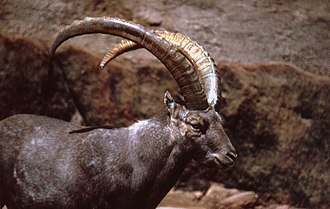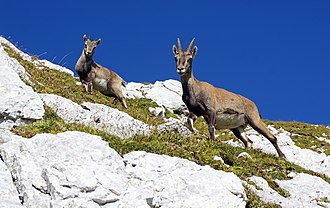Welcome back. Today at Think Wildlife Foundation we are going to address a positive and a successful story of how we humans saved an excellent climber “The Alpine Ibex” from the brink of extinction. We always talk about how wildlife is in the danger, how some species are in the danger some are on the verge of extinction, how the forests are getting burned down to the ashes every year. We humans are causing harm to the wildlife and the forests but we are also aware of this situation and we all are taking some effective steps towards saving our beautiful nature and animals. We have noticed youngsters are very aware and are concerned about such matters and they are working very hard to save endangered species and forests.
So, we are giving a push to all such Wildlife lovers with a positive and a successful story of Ibex.

What is an Ibex?
Ibex is a wild mountain goat found in Europe, parts of Asia and norteastern Africa with their very thick coat and powerful hind legs, they are adapted to live in very harsh terrain. Their classical horns can scare off predators like wolves, lynx and foxes .Male Ibex horns can grow up in between 70 centimetres to 140 centimetres long, definitely not to be messed with! They can jump up to 1.8 meters into air without a running start. But their specialty is their Ibex hooves they have sharp edges and concave undersides that act like suction cups to help them grip the sides of steep, rocky cliffs. Ibex molt (they have thicker fur during the colder winter months to keep them warm, then around spring and summer they shed some of their fur to get a thinner coat for the warmer summer months this is known as molting) twice a year, firstly in April or May, and then again in September, when they replace the short summer coat with thicker hair and a woolly undercoat.100000 Years ago, Ibex roamed widely across Europe’s Rocky Mountains these Ibex are masters of climbing they are able to scale impossible looking rock walls, these goats used to find in central Europe.
Being able to climb high mountains used to protect Ibex from predators who cannot follow them. until they faced a fearsome hunter who wouldn’t give up “Humans”. Worlds five species of Ibex have had a hard time. Only one species of Ibex has managed to thrive against all the odds and come back from the brink of extinction.

The Alpine Ibex
They are very hard to capture because of their extraordinary climbing skills a pair of Ibex horns was regarded as the ultimate trophy this became a huge problem and then the numbers of Alpine Ibex started to fall. They became extinct in Germany and Switzerland then there were only 50 to 100 individuals left in the northern Italy and France the devastation was overwhelming some sources suggested that only 0.1% of original population was left, this tells the Alpine Ibex was really on the edge of extinction.
Back from brink for the Alpine Ibex
Then something good finally happened becoming aware of what was happening the government of Piedmont banned Ibex hunting but still the hunt was continued then Italian king Vittorio Emmanuele II created a royal hunting reserve in 1856. It was for the sole use of the king who was himself an Ibex hunter. Well-known local hunters were hired to guard the animals and patrol the reserve it was so tactic and incredibly worked. Over next 60 years the Alpine Ibex population increased around 3000 animals then in 1919 king Vittorio Emmanuele III donated the royal hunting reserve to the Italian state and in 1922 it was officially renamed Gran Paradiso National Park. This was the best move in preventing the extinction of the Alpine Ibex and made Gran Paradiso Italy’s first national park after increasing population was noticed then the numbers of Ibex were also introduced to the Swiss Alps. Today this beautiful animal is found in Switzerland, Italy, Austria, France, Germany Slovenia and also in Bulgaria. Now there are 50,000 Ibex living in the alps all of these are descended from that last colony protected in Gran Paradiso so the IUCN (The International Union for Conversation of Nature) red list now classifies the species as least concern. It’s been an amazing turn around for an animal that could have easily disappeared from the mountains.
But there is more.

Present threats to the Ibex
Humans almost destroyed and then saved the Alpine Ibex, but now it is facing another threat that is made by us humans. The Alps are experiencing climate change at very high-rate temperature rise in 20th century raise by 1.4 degrees Celsius but it has risen by two degrees Celsius in the alps, due to this over last 50 to 60 years spring has arrived between two to five days earlier every decade. This affects majorly on animals like the Ibex scientists have observed a higher mortality rate among young Alpine Ibex because they believe it has to do with the shifting onset of spring, which causes plants to flourish sooner. The animals are also suffering from an upsurge in parasites which thrive in warmer temperatures. Disease carriers such as worms and ticks have been found at increasingly high altitudes even up to 1700 meters all these changes are threatening the Alpine Ibex, for the Ibex it was a long hard climb back to the verge of extinction but these mountain dwellers succeeded even against formidable odds.
Now again it’s up to us humans to ensure its rocky future is saved.
Written By- Atharv Deshmukh
Help us Help Them! Think Wildlife Foundation is a non profit organization with various conservation initiatives. Our most prominent campaign is our Caring for Pari intiative. Pari is a rehabilitated elephant at the Wildlife SoS Hospital. 25% of the profits from our store are donated to the elephant hospital for Pari. Other than buying our wonderful merchandise, you could donate directly to our Caring For Pari fundraiser.
